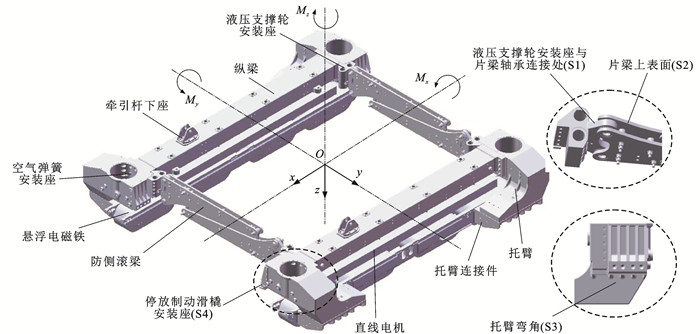Strength evaluation of levitation frame for medium and low speed maglev train based on full-scale bench test
-
摘要: 为评估某中低速磁浮列车悬浮架构架是否满足强度要求,利用自主研发的全尺寸中低速磁浮强度试验台对该悬浮架构架开展了静强度与疲劳强度试验,基于有限元和多体动力学仿真结果,确定了悬浮架构架的应力集中部位与承载特性;据此,在悬浮架构架上合理布置了系列测点,测量了车辆在超常载荷、模拟主要运营载荷和模拟特殊运营载荷3类工况下悬浮架构架的应变响应信号,根据悬浮架构架不同部位的材料特性,通过转换计算评估了悬浮架构架的应力水平。研究结果表明:在静强度试验中,悬浮架构架的较大应力点主要分布于托臂拐角、支撑轮安装座与防侧滚梁连接处、停放制动滑橇安装座等处,而在疲劳强度试验中的薄弱点主要为纵梁与托臂连接的焊缝处;相比于列车的常规运行工况,在悬浮失效、超载落车制动等特殊运行条件下,悬浮架构架的静强度和疲劳强度的应力幅值分别增加了1.06和4.77倍;所有测试工况下悬浮架构架受到的最大拉应力、最大压应力分别为67.22、-20.30 MPa,且最小安全系数为1.71,说明悬浮架构架满足结构强度要求;所有测试数据结果均在各自材料的Goodman-Smith疲劳极限图包络线内,说明悬浮架构架满足疲劳强度要求;经渗透探伤查验,悬浮架构架的任何位置上均未发现裂纹,验证了悬浮架构架疲劳强度评估结果的可靠性。Abstract: In order to evaluate whether the levitation frame of a medium and low speed maglev train meets the requirements of strength, the static strength and fatigue strength tests of the levitation frame were conducted by using the self-developed full-scale medium and low speed maglev strength test bench. According to the finite element analysis and the results obtained from multi-body dynamics simulation, the stress concentration position and bearing characteristics shown by the levitation frame were determined, followed by the reasonable arrangement of measuring points in a series on the levitation frame. The signals of strain response shown by the levitation frame of the train under three types of working conditions were measured, including extraordinary load, simulated main operation load, and simulated special operation load. Based on the material properties displayed by different parts of the levitation frame, the stress level of the levitation frame was evaluated through transformation calculation. Research results show that in the static strength test, large stress points of the levitation frame are mainly distribute at the corner of the bracket, the connection point between the mounting seat of support wheels and the anti-rolling beam, and the mounting seat of the parking brake sled, while the weak point obtained from the fatigue strength test is mainly at the weld joint between the longitudinal beam and the bracket. In comparison with the conventional operating conditions of the train, the stress amplitude values of the static strength and fatigue strength of the levitation frame increase by 1.06 and 4.77 times respectively under special operation conditions such as levitation failure and overloading braking. The maximum tensile stress and compressive stress of the levitation frame under all test conditions are 67.22 and -20.30 MPa, respectively, with the minimum safety factor as 1.71, indicating that the levitation frame meets the structural strength requirements. All the test data are within the envelope of the Goodman-Smith fatigue limit diagram of the corresponding material, indicating that the levitation frame meets the fatigue strength requirements. Through penetration inspection, it is identified that no cracks are found at any position of the levitation frame, which verifies the reliability of fatigue strength evaluation results of the levitation frame.
-
Key words:
- vehicle engineering /
- medium and low speed maglev /
- field test /
- levitation frame /
- bench test /
- strength evaluation
-
表 1 悬浮架构架材料应力参数
Table 1. Stress parameters of levitation frame materials
材料 材料特征/mm 母材 焊缝 σw/MPa Rm/MPa Rs/MPa Rm/MPa Rs/MPa EN AW 6005A t≤5 255 215 165 115 51 5<t≤10 250 200 165 115 50 EN AW 5083 t≤50 275 125 275 125 55 50 < t≤80 270 115 270 115 54 EN AC 42100 240 190 70 EN AW 6082 t≤6 310 260 185 125 62 6<t≤12.5 300 255 185 125 60 12.5<t≤100 295 240 185 125 59 d≤80 310 255 185 125 62 表 2 加载与约束位置
Table 2. Loading and constraint positions
约束编号 约束方向/位置 加载编号 载荷类型/位置 C01~C04 垂向/悬浮电磁铁工装 Z01、Z02 垂向力/空气弹簧工装 C05、C06 横向/防侧滚梁 Z03、Z04 横向力/空气弹簧工装 C07 纵向/牵引杆工装 Z05 纵向力/牵引电机工装 C08、C09 垂向/停放制动滑橇工装 Z06 纵向力/悬浮电磁铁工装 C10、C11 垂向/液压支撑轮工装 表 3 静强度试验工况
Table 3. Test conditions of static strength
载荷类型 工况名称 载荷/kN 加载编号 约束编号 Fx Fy Fz 超常载荷 静态悬浮 16.21 Z01、Z02 C01~C07 停放制动滑橇落车 16.21 C05~C09 救援轮落车 16.21 C05~C07、C10、C11 直线段牵引/电制动 ±5.04 16.21 Z01、Z02、Z05 C01~C07 机械制动 ±12.60 16.21 Z01、Z02、Z06 悬浮运行 5.04 2.03 16.21 Z01~Z05 侧风 5.04 ±7.16 26.60 Z01~Z05 运营载荷 直线段牵引/电制动 ±3.40 10.59 Z01、Z02、Z05 机械制动 ±4.42 10.59 Z01、Z02、Z06 侧风 3.40 ±7.12 11.60 Z01~Z05 道岔 3.40 ±9.64 22.46 Z01~Z05 特殊载荷 悬浮失效 1.10 20.00 Z01~Z04 空气弹簧失效 3.40 1.00 21.61 Z01~Z04 超载落车制动 14.13 24.72 Z01、Z02、Z05 C05~C09 空车救援 2.58 15.89 Z01、Z02、Z05 C05~C07、C10、C11 表 4 疲劳强度试验载荷
Table 4. Fatigue strength test loads
工况 载荷计算 载荷/kN Fx Fy Fz 1 Fz 10.59 2 (1+α-β)Fz 3.40 9.53 3 3.40 1.74 9.53 4 (1+α+β)Fz 3.40 13.76 5 3.40 1.74 13.76 6 (1-α-β)Fz 3.40 7.41 7 3.40 -1.74 7.41 8 (1-α+β)Fz 3.40 11.65 9 3.40 -1.74 11.65 10 (1+α-β)Fz -3.40 9.53 11 -3.40 1.74 9.53 12 (1+α+β)Fz -3.40 13.76 13 -3.40 1.74 13.76 14 (1-α-β)Fz -3.40 7.41 15 -3.40 -1.74 7.41 16 (1-α+β)Fz -3.40 11.65 17 -3.40 -1.74 11.65 -
[1] 翟婉明, 赵春发. 现代轨道交通工程科技前沿与挑战[J]. 西南交通大学学报, 2016, 51(2): 209-226. doi: 10.3969/j.issn.0258-2724.2016.02.001ZHAI Wan-ming, ZHAO Chun-fa. Frontiers and challenges of sciences and technologies in modern railway engineering[J]. Journal of Southwest Jiaotong University, 2016, 51(2): 209-226. (in Chinese) doi: 10.3969/j.issn.0258-2724.2016.02.001 [2] 徐飞, 罗世辉, 邓自刚. 磁悬浮轨道交通关键技术及全速度域应用研究[J]. 铁道学报, 2019, 41(3): 40-49. doi: 10.3969/j.issn.1001-8360.2019.03.006XU Fei, LUO Shi-hui, DENG Zi-gang. Study on key technologies and whole speed range application of maglev rail transport[J]. Journal of the China Railway Society, 2019, 41(3): 40-49. (in Chinese) doi: 10.3969/j.issn.1001-8360.2019.03.006 [3] ZHANG Min, LUO Shi-hui, GAO Chang, et al. Research on the mechanism of a newly developed levitation frame with mid-set air spring[J]. Vehicle System Dynamics, 2018, 56(12): 1797-1816. doi: 10.1080/00423114.2018.1435892 [4] 蔡文锋, 颜华, 杨平. 中低速磁浮轨道系统特点及工程适应性分析[J]. 铁道工程学报, 2015, 32(2): 54-59. doi: 10.3969/j.issn.1006-2106.2015.02.011CAI Wen-feng, YAN Hua, YANG Ping. Analysis of the characteristics and engineering adaptability of track system for medium and low speed maglev transit[J]. Journal of Railway Engineering Society, 2015, 32(2): 54-59. (in Chinese) doi: 10.3969/j.issn.1006-2106.2015.02.011 [5] 马卫华, 罗世辉, 张敏, 等. 中低速磁浮车辆研究综述[J]. 交通运输工程学报, 2021, 21(1): 199-216. doi: 10.19818/j.cnki.1671-1637.2021.01.009MA Wei-hua, LUO Shi-hui, ZHANG Min, et al. Research review on medium and low speed maglev vehicle[J]. Journal of Traffic and Transportation Engineering, 2021, 21(1): 199-216. (in Chinese) doi: 10.19818/j.cnki.1671-1637.2021.01.009 [6] 胡齐斌. 新型中低速磁浮列车悬浮架强度试验方法研究[D]. 成都: 西南交通大学, 2020.HU Qi-bin. Research on the strength test method of the levitation bogie for new-type mid-low speed maglev vehicle[D]. Chengdu: Southwest Jiaotong University, 2020. (in Chinese) [7] 杨磊. 中低速磁浮列车转向架特性分析及计算[D]. 长沙: 国防科学技术大学, 2003.YANG Lei. Analysis and calculation of bogie characteristics of medium and low speed maglev vehicle[D]. Changsha: National University of Defense Technology, 2003. (in Chinese) [8] 周益, 刘放, 李飞, 等. 运用SolidWorks和ANSYS的磁浮列车悬浮架结构有限元分析[J]. 现代制造工程, 2012(8): 17-20. doi: 10.3969/j.issn.1671-3133.2012.08.005ZHOU Yi, LIU Fang, LI Fei, et al. Finite element analysis of the levitation chassis of maglev vehicle based on SolidWorks and ANSYS[J]. Modern Manufacturing Engineering, 2012(8): 17-20. (in Chinese) doi: 10.3969/j.issn.1671-3133.2012.08.005 [9] LEE H W, KIM K C, LEE J. Review of maglev train technologies[J]. IEEE Transactions on Magnetics, 2006, 42(7): 1917-1925. doi: 10.1109/TMAG.2006.875842 [10] ZHOU Dan-feng, HANSEN C H, LI Jie, et al. Review of coupled vibration problems in EMS maglev vehicles[J]. International Journal of Acoustics and Vibration, 2010, 15(1): 10-23. [11] XIU Rui-xian, SPIRYAGIN M, WU Qing, et al. Fatigue life assessment methods for railway vehicle bogie frames[J]. Engineering Failure Analysis, 2020, 116: 104725. doi: 10.1016/j.engfailanal.2020.104725 [12] KASSNER M. Fatigue strength analysis of a welded railway vehicle structure by different methods[J]. International Journal of Fatigue, 2012, 34(1): 103-111. doi: 10.1016/j.ijfatigue.2011.01.020 [13] ODA Y, YAGI T, OKINO T, et al. Fatigue life estimation for welds of truck frames for rolling stock using stress frequency in service load[J]. Japan Society of Mechanical Engineers, 2007, 73(10): 1171-1176. [14] GRASSO M, XU Y, RUSSO R, et al. Mixed mode fatigue crack propagation behaviour of aluminium F357 alloy[J]. Engineering Failure Analysis, 2018(90): 463-475. [15] SARUNAC R. "Low Speed" magnetic levitation vehicle in the US[C]//IEEE. Proceedings of the IEEE/ASME Joint Railroad Conference. New York: IEEE, 1999: 130-143. [16] HAN S W, WOO K J. Evaluation of dynamic fatigue life for maglev bogie frame[J]. Journal of the Korean Society for Railway, 2010, 13(1): 1-8. [17] KIM J S. Fatigue assessment of tilting bogie frame for Korean tilting train: analysis and static tests[J]. Engineering Failure Analysis, 2006, 13(8): 1326-1337. doi: 10.1016/j.engfailanal.2005.10.007 [18] HAN J W, KIM J D, SONG S Y. Fatigue strength evaluation of a bogie frame for urban maglev train with fatigue test on full-scale test rig[J]. Engineering Failure Analysis, 2013, 31: 412-420. doi: 10.1016/j.engfailanal.2013.01.009 [19] 吴开洪, 崔建昆. 磁悬浮列车转向架的变形状态分析[J]. 现代机械, 2017(1): 34-36.WU Kai-hong, CUI Jian-kun. The deformation state analysis of the bogie on a maglev train[J]. Modern Machinery, 2017(1): 34-36. (in Chinese) [20] 罗圩琪, 许平, 谢卓君. 磁浮列车走行机构结构优化研究[J]. 城市轨道交通研究, 2011, 14(11): 86-89, 92. doi: 10.3969/j.issn.1007-869X.2011.11.020LUO Yu-qi, XU Ping, XIE Zhuo-jun. Research on structure optimization of running gear of maglev train[J]. Urban Mass Transit, 2011, 14(11): 86-89, 92. (in Chinese) doi: 10.3969/j.issn.1007-869X.2011.11.020 [21] 姚生军, 汤劲松, 李东锋. 中低速磁浮列车动载荷及动应力测试研究[J]. 铁道车辆, 2013, 51(5): 1-4.YAO Sheng-jun, TANG Jin-song, LI Dong-feng. Research on dynamic load and stress measurement for maglev trains with middle and low speed[J]. Rolling Stock, 2013, 51(5): 1-4. (in Chinese) [22] 宗凌潇. 时速140 km新型中低速磁浮列车走行机构研究分析[D]. 成都: 西南交通大学, 2016.ZONG Ling-xiao. A research to running mechanism of new medium-low speed maglev train with its speed being 140 km·h-1[D]. Chengdu: Southwest Jiaotong University, 2016. (in Chinese) [23] 吴元科, 刘放, 张斌, 等. 长定子中低速磁浮列车悬浮架疲劳寿命分析[J]. 现代制造工程, 2016(8): 54-59, 94.WU Yuan-ke, LIU Fang, ZHANG Bin, et al. Fatigue life analysis of levitation chassis of long stator maglev vehicle[J]. Modern Manufacturing Engineering, 2016(8): 54-59, 94. (in Chinese) [24] 彭奇彪, 罗华军, 佟来生, 等. 中低速磁浮车辆悬浮架的技术特征[J]. 电力机车与城轨车辆, 2012, 35(6): 7-11.PENG Qi-biao, LUO Hua-jun, TONG Lai-sheng, et al. Characteristics of maglev bogie for mid-low speed maglev vehicle[J]. Electric Locomotives and Mass Transit Vehicles, 2012, 35(6): 7-11. (in Chinese) [25] 迟振华. 长定子中低速磁浮列车悬浮架疲劳强度研究[D]. 成都: 西南交通大学, 2014.CHI Zhen-hua. Research on fatigue strength for levitation chassis of long stator middle-low speed maglev vehicle[D]. Chengdu: Southwest Jiaotong University, 2014. (in Chinese) [26] 李岑, 姚毓瑾, 虞大联, 等. 基于动力学仿真分析的磁悬浮列车悬浮架载荷特征研究[J]. 北京交通大学学报, 2021, 45(3): 118-125.LI Cen, YAO Yu-jin, YU Da-lian, et al. Study on load characteristics of maglev train suspension frame based on dynamics simulation analysis[J]. Journal of Beijing Jiaotong University, 2021, 45(3): 118-125. (in Chinese) [27] 赵军. 中低速磁浮列车车体轻量化设计[D]. 成都: 西南交通大学, 2017.ZHAO Jun. Light weight design of medium-low speed maglev train carbody[D]. Chengdu: Southwest Jiaotong University, 2017. (in Chinese) [28] 李苗, 马卫华, 龚俊虎, 等. 中低速磁浮车辆-桥梁耦合系统动力性能试验[J]. 交通运输工程学报, 2022, 22(1): 141-154. doi: 10.19818/j.cnki.1671-1637.2022.01.012LI Miao, MA Wei-hua, GONG Jun-hu, et al. Dynamic performance test of medium and low speed maglev vehicle-bridge coupled system[J]. Journal of Traffic and Transportation Engineering, 2022, 22(1): 141-154. (in Chinese) doi: 10.19818/j.cnki.1671-1637.2022.01.012 [29] 魏德豪, 罗世辉, 王晨. 牵引杆对中低速磁浮动力学性能影响分析[J]. 机械设计与制造, 2018(12): 92-95.WEI De-hao, LUO Shi-hui, WANG Chen. Analysis on the influences of traction rod to medium-low speed maglev dynamic performance[J]. Machinery Design and Manufacture, 2018(12): 92-95. (in Chinese) [30] 任治军. 中低速磁浮列车转向架疲劳寿命分析和仿真[D]. 长沙: 国防科学技术大学, 2005.REN Zhi-jun. Fatigue analysis and simulation of maglev bogie in low and medium speed maglev train[D]. Changsha: National University of Defense Technology, 2005. (in Chinese) [31] 沈彩瑜. 铁道车辆转向架构架疲劳强度研究[D]. 成都: 西南交通大学, 2014.SHEN Cai-yu. Fatigue strength analysis of the welded bogie frame for railway vehicle[D]. Chengdu: Southwest Jiaotong University, 2014. (in Chinese) -





 下载:
下载:










